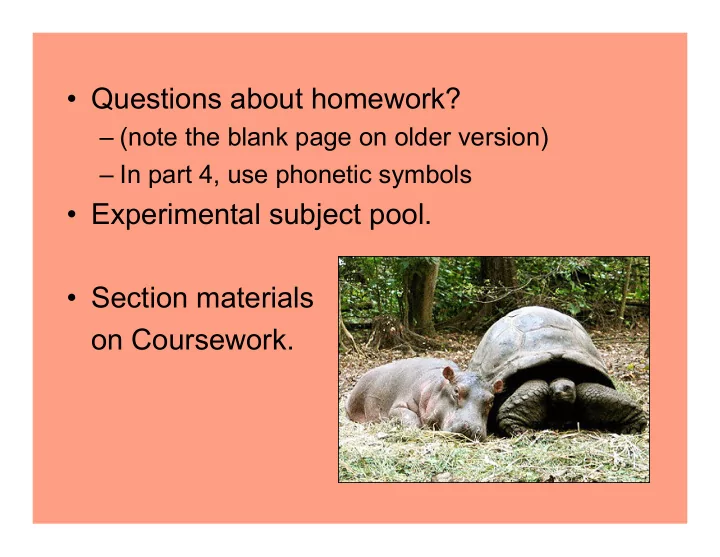

• Questions about homework? – (note the blank page on older version) – In part 4, use phonetic symbols • Experimental subject pool. • Section materials on Coursework.
Today: • A little more about articulatory phonetics and transcription • Introduction to Acoustic Phonetics – Sound waves and resonance – Spectrograms as representations of sound
[tajnib ɪ p ˺ m ɔɺ a ɺ t ɪ kj əӚ l əӚ t ɔɺ if əӚ n ɛɾɪ ks] • How close a transcription? – e.g. aspirated, unreleased stops – [ ɺ ] vs [ ɚ ]; [ow] vs [o ʊ ] – your choice I • But [ ɑʊ ] for about? [p h ʌ li:z]. • Knowing how to characterize phones – voicing – place – manner
[sm ɺ is ɔɺ s əӚ z] I • A better site showing vocal folds in action: https://mustelid.physiol.ox.ac.uk/drupal/?q=vocal_folds • A movie showing how to break a glass with sound: http://www.physics.ucla.edu/demoweb/demomanual/acoustics/effects_of_sound/breaking_glass_with_sound.html • A site for learning acoustic phonetics and praat: http://person2.sol.lu.se/SidneyWood/praate/frames.html
Resonance: F0 and harmonics http://www.exploratorium.edu/exhibits/vocal_vowels/vocal_vowels.html
Sally sells sea shells…
2725 hz 852 hz 1226 hz 304 hz 400 hz 780 hz i u a Vowels and resonance
Formants and vowel quality • The first formant corresponds to vowel height, i.e. open-ness (higher values = lower jaw/tongue positions) • The second formant corresponds to frontness-backness (higher values=greater tongue fronting)
f1-f2 Plot of iua i u a
Language comes out in a continuous stream, which we learn to hear as a succession of discrete segments.
Spectrogram of sigh Note the curving formants that distinguish the diphthong [aj]. F2 F1 s ɑ j
We can clearly see the [s], the [ ɑ ] and the [j] F2 F1 s ɑ j
And we can see the transition from [ ɑ ] to [j] F2 F1 s ɑ j
but .. what’s this? F2 F1 s ɑ j Take a look at this in Praat
Phonetic processes Language comes out in a continuous stream, which we learn to hear as a succession of discrete segments. In the case of sigh , there is information about the consonant in the following vowel. In this way, segments overlap in the stream of speech, yet we learn to hear them as purely sequential. These coarticulations can become exaggerated, and can lead to change. We will begin our study of phonology next week, by examining some processes by which sounds are affected by their phonetic environment.
Recommend
More recommend